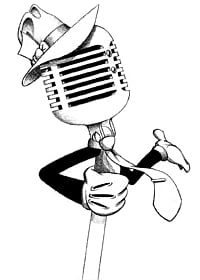HELPFUL RECORDING TIPS!
THE RECORDING PROCESS
Tracking: Having the full group lay the song down. Usually, the focus is on the rhythm section here, especially the drums.
Overdubs: With solid drums down, then the other instruments and vocals are fixed or added to the original tracking performances.
Mixing: The blending of all of the individually recorded tracks into a master stereo, or 5.1, track ready for mastering.
Mastering: The assembly of all of the final mixes into the correct order. Here they also match volumes, stereo compress and EQ as well as normalize the full project for continuity, presence and impact.
In general, while you’re recording, if you make a small slip up, don’t stop. Finish the full take and let the engineer/producer punch in the boo boo. Doing the part over and over again can easily wear you out.
If you’re not happy with a take or sound, tell someone. Chances are you can get the engineer/producer to let you try it again unless they have an extremely good reason for holding on to it. But if it’s going to ruin the enjoyment of listening to this recording for years to come for you, do it again. Never assume it can be “fixed in the mix.”
Always record the tracks as clean as possible and add effects later.
Know when to say when. If you’re toast, you won’t be playing your best. Schedule to come back when you have your wits about you.
Don’t be afraid of space. Sometimes the silence is just as important as the sound in a song. Don’t stuff it too full of stuff. It will make the song sound cluttered and much harder to mix.
Use one tuner for everyone. Tuners can lose their calibration. So one tuner can be a few cents off from another. Tune a lot. You can’t tune too often.
It’s your session so if you would like to bring guests, that’s your decision. However, guests can distract you and may sway your opinion about the way the music should sound. Typically, leaving them in the lobby if they have to be there is a safe move.
The studio is one place you can’t afford to have “too many Chiefs and not enough Indians.” This is why we have Producers. If you’re using one, trust him. Limit the number of people in the studio at a single time who have a say in how things are being recorded.
PRODUCER: Quality control. The producer is the one who is critical of the performances and construction of the material. They are the ones who say “late, early, sharp, flat, not purple enough, too much Eddie Vedder – not enough Sinatra – DO IT AGAIN.” Their contribution is intellectual. Some producers never touch a button.
ENGINEER: The tech. The Head Engineer is the one selecting the mics, twiddling the knobs and pressing “Play” and “Record.” Second or Assistant Engineers are the ones setting up the selected microphones, filling out track sheets, labeling tapes and taking the blame for everything that goes wrong. A Runner is the burger-chaser and trash emptier.
In smaller studios in smaller markets, one person may do all of these jobs.
Bring food and drinks to your engineer/producer and he will love you for life – and will probably work harder for you.
If your music tracking time has gone long, don’t cut the vocals and mixing short to stay in budget. Take a break, earn more money and come back when you can afford to do it right. You’re not there to do it wrong.
When cutting tracks, especially overdubs, monitor at softer levels. It may not have the impact of 10,000 watts of unadulterated power, but you’ll be able to hear detail much better and improve your tightness tenfold.
